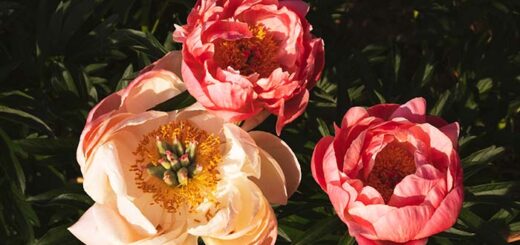When to Transplant Peonies
While you can technically transplant peonies at different times of the year, the optimal period is September. By this time, the plant’s tubers have absorbed nutrients from the foliage and are prepared for the upcoming growth season. Transplanting in September allows the roots to establish themselves before the first hard frost, increasing the chances of a successful transplant.
Why Timing Matters for Transplanting Peonies
Timing is crucial when transplanting peonies to ensure the plant’s health and blooming potential. Peonies, known for their large, vibrant flowers, typically bloom in late spring to early summer. However, the plant enters dormancy by late summer or early fall, making it the ideal time for transplanting.
Spring and Summer Transplanting
Transplanting peonies in spring or summer is possible but comes with risks. The plant is actively growing during these seasons, which can stress the peony and reduce the likelihood of successful establishment. If you transplant in spring or summer, be prepared for the possibility that the plant might not bloom for a couple of years as it recovers and adjusts.
Preparing the Soil for Transplanting Peonies
Healthy soil is vital for the successful transplantation of peonies. Ensuring the soil meets the peony’s requirements will help the plant establish quickly and thrive in its new environment.
Soil Composition and pH
Peonies prefer fertile, well-draining soil with a pH between 6 and 7. Testing your soil’s pH and amending it as necessary can create the perfect conditions for your peonies. Adding organic matter, such as compost, can improve soil fertility and drainage.
Watering and Drainage
Proper watering is crucial, especially after transplanting. Ensure the planting area is well-watered but not waterlogged, as overly wet conditions can lead to tuber rot. Dry soil, on the other hand, can cause transplant failure. Maintaining consistent moisture levels helps the roots establish themselves.

Image Source: Envato Elements
Step-by-Step Guide to Transplanting Peonies
Transplanting peonies involves several steps to ensure the plant’s health and future blooms. Follow these instructions for a successful transplant.
1. Preparing the Plant
- Trim back the peony plant to reduce stress and make handling easier.
- Using a shovel, carefully dig around the entire shrub to preserve as much of the root ball as possible. Dig several inches in a circle around the plant, leaving 8 to 10 inches of soil from the peony stems. Dig about 6 inches below the tubers to avoid damaging the root system.
2. Dividing the Plant
- Depending on the size of the peony plant, decide how many sections to split it into. Use a clean, sharp knife to cut through the root ball, ensuring each section has at least three buds. Shake off excess soil and remove any dead growth or thread-like roots.
3. Replanting the Tubers
- Replant the tubers with their growth buds no more than two inches beneath the soil surface, ensuring they face upward. Planting too deep can prevent blooming.
- Backfill and firm the soil around the tubers. Adding 1-2 inches of organic mulch during winter helps protect the transplant from frost heaves.
4. Post-Transplant Care
- After transplanting, water the area thoroughly and keep the soil consistently moist. Applying bone meal or an organic fertilizer can give the peonies a nutrient boost, promoting healthy growth and future blooms.
- Be patient, as peonies may not produce flowers in the first year after transplanting. Proper care will reward your efforts with beautiful blooms in subsequent seasons.
Common Questions About Transplanting Peonies
1. Can I Transplant Peonies in Spring?
While spring transplanting is possible, it could be better. The plant’s active growth phase can make it more susceptible to stress. If you must transplant in spring, take extra care to minimize root disturbance and provide consistent moisture.
2. How Deep Should I Plant Peony Tubers?
Plant the tubers with their growth buds no more than two inches below the soil surface. Planting them deeper can inhibit blooming, so careful attention to depth is crucial.
3. What Type of Mulch Should I Use?
Organic mulch, such as compost or shredded bark, works well for peonies. It helps retain moisture, regulate soil temperature, and protect the plant from frost heaves in winter.
4. How Long Will Peonies Bloom After Transplanting?
Peonies may take a year or more to bloom after being transplanted. The plant needs time to recover and establish its root system. Be patient, and with proper care, you’ll enjoy beautiful blooms in the following seasons.
5. What Should I Do If My Peonies Don’t Bloom?
Check the planting depth, soil conditions, and overall plant health if your peonies don’t bloom. Ensuring the tubers are planted enough, the soil is well-draining and fertile, and the plant receives adequate sunlight can help encourage blooming.
Conclusion
Successfully transplanting peonies requires attention to timing, soil conditions, and careful handling of the plant. Following these guidelines, you can ensure your peonies thrive in their new location and reward you with stunning blooms.
FAQs on When to Transplant Peonies
Q: Can I transplant peonies if they are already blooming?
A: Transplanting peonies while they are blooming is not recommended. The best time to transplant peonies is during their dormancy period in the fall, preferably in September. Transplanting during the blooming season can stress the plant and potentially hinder future blooms.
Q: How often should I divide and transplant my peonies?
A: Peonies generally do not need to be divided and transplanted frequently. Every 10 to 15 years is usually sufficient unless the plants become overcrowded or stop blooming as vigorously. Over-dividing can stress the plants, so only do it when necessary.
Q: What should I do if my transplanted peonies are not blooming?
A: If your transplanted peonies are not blooming, check the planting depth, soil conditions, and sunlight exposure. Ensure the tubers are planted no more than two inches deep, the soil is well-draining and fertile, and the plants receive at least 6 hours of direct sunlight daily. It may also take a couple of years for peonies to adjust and bloom again after being transplanted.
Q: Can I transplant peonies into containers or pots?
A: While peonies can be grown in containers, they are not ideal for long-term health. Peonies have extensive root systems and prefer to be planted in the ground where they can spread out. If you must use a container, choose one large and deep, ensuring it has good drainage. Transplant the peonies into the ground immediately for the best results.
Q: Are there specific types of peonies that are easier to transplant?
A: Herbaceous peonies are generally easier to transplant compared to tree peonies. Herbaceous peonies die back to the ground each year, making them more adaptable to being moved. Tree peonies have woody stems and can be more sensitive to transplanting. Starting with herbaceous peonies might be easier if you are new to gardening.
Q: Can I use chemical fertilizers on transplanted peonies?
A: It is best to use organic fertilizers, such as bone meal or compost when caring for transplanted peonies. Chemical fertilizers can be too harsh and may damage the roots. Organic fertilizers provide a slow release of nutrients that promote healthy growth without the risk of burning the plant.
Q: How can I protect my transplanted peonies from extreme weather conditions?
A: To protect transplanted peonies from extreme weather and frigid winters, apply a thick layer of mulch around the base of the plant. This helps insulate the roots and prevents frost heaving. Providing some afternoon shade can protect the plants from excessive heat and sun stress in scorching climates.
Q: Can I transplant peonies near other perennials or shrubs?
A: You can transplant peonies near other perennials or shrubs, but ensure they have enough space to grow without competition. Peonies require good air circulation and ample sunlight. Avoid planting them too close to large trees or shrubs that might overshadow them or compete for nutrients and water.
Q: What are the signs that my peonies need to be transplanted?
A: Signs of peonies needing to be transplanted include reduced blooming, overcrowded clumps, or poor overall plant health. If you notice these issues, consider dividing and transplanting the peonies to rejuvenate them and promote healthier growth and blooming.
Q: Can I transplant peonies if they have a disease?
A: If your peonies show signs of disease, such as leaf spots or mildew, it is best to address the disease before transplanting. Remove any infected foliage and treat the plant with appropriate fungicides. Transplanting a diseased plant can spread the disease to a new location and further stress the plant.
Additional Tips for Caring for Transplanted Peonies
Here are some additional tips and insights to help you nurture your transplanted peonies and maximize their health and blooming potential.
1. Choosing the Right Location
Peonies thrive in full sun, requiring at least 6 hours of direct sunlight daily. Choose a location with ample sunlight and good air circulation to prevent fungal diseases. Avoid planting peonies too close to large trees or shrubs, as their roots can compete for nutrients and water.
2. Preparing the Planting Site
Before transplanting, prepare the planting site by loosening the soil to a depth of 12 to 18 inches. This helps the roots penetrate the soil more quickly and establish themselves. Incorporate organic matter, such as compost or aged manure, to enhance soil fertility and structure.
3. Watering Practices
Consistent watering is essential for newly transplanted peonies. Water deeply to encourage the roots to grow downward, but avoid overwatering. The soil should be moist but not waterlogged. Mulching helps retain moisture and reduces the frequency of watering.
4. Fertilizing Peonies
While peonies do not require heavy feeding, providing them with the proper nutrients can promote healthy growth and blooming. Apply a balanced, slow-release fertilizer in early spring when new growth appears. Avoid high-nitrogen fertilizers, as they can encourage foliage growth at the expense of blooms.
5. Monitoring for Pests and Diseases
Peonies are generally hardy plants, but they can still be affected by pests and diseases. Common pests include aphids, ants, and spider mites. Regularly inspect your plants for signs of infestation and treat them with appropriate organic or chemical controls if needed.
Peonies are also susceptible to fungal diseases like botrytis blight and powdery mildew. Ensuring good air circulation and avoiding overhead watering can help prevent these issues. If you notice any signs of disease, remove and dispose of affected plant parts and apply a fungicide if necessary.
6. Supporting Peony Stems
Peony blooms can be heavy, especially after rain, causing the stems to bend or break. Installing plant supports or staking the stems early in the growing season can help keep the blooms upright and prevent damage. Use soft ties or garden twine to secure the stems to the supports.
7. Deadheading Spent Blooms
After the peonies have finished blooming, deadheading (removing spent flowers) helps the plant conserve energy and maintain a tidy appearance. Cut the spent blooms just above the first set of healthy leaves. This practice encourages the plant to focus on root and foliage development for the next growing season.
8. Dividing Overgrown Peonies
If your peony plants become overcrowded or stop blooming as vigorously, it may be time to divide them. Dividing peonies rejuvenates the plant and promotes better blooming. Follow the same steps for transplanting, ensuring each division has at least three buds and a healthy root system.
9. Preparing for Winter
In colder climates, peonies benefit from winter protection. After the first hard frost, cut back the foliage to the ground and apply a thick layer of mulch to insulate the roots. Remove the mulch in early spring before new growth begins to avoid smothering the emerging shoots.
10. Enjoying Your Peonies
With proper care and attention, your transplanted peonies will reward you with stunning blooms year after year. These hardy perennials are a delightful addition to any garden, offering beauty and elegance with their showy flowers and lush foliage.
Common Myths About Transplanting Peonies
There are several myths and misconceptions about transplanting peonies. Let’s debunk a few to help you make informed decisions for your garden.
Myth 1: Peonies Should Not Be Transplanted
While peonies can be finicky, they can be successfully transplanted with the proper care and timing. Following the guidelines in this article will help ensure a smooth transition and healthy growth.
Myth 2: Peonies Only Bloom Once
Although peonies have a short blooming period, they can provide spectacular displays year after year with proper care. Ensuring the plant’s needs are met can result in reliable blooms each season.
Myth 3: Peonies Require Constant Attention
Once established, peonies are relatively low-maintenance. They do not require frequent fertilizing or watering, making them an excellent choice for gardeners who prefer low-maintenance plants.
Myth 4: All Peonies Smell Alike
Peonies come in various cultivars, some with strong fragrances and others with little to no scent. When selecting peonies for your garden, consider your preference for fragrance and choose accordingly.


